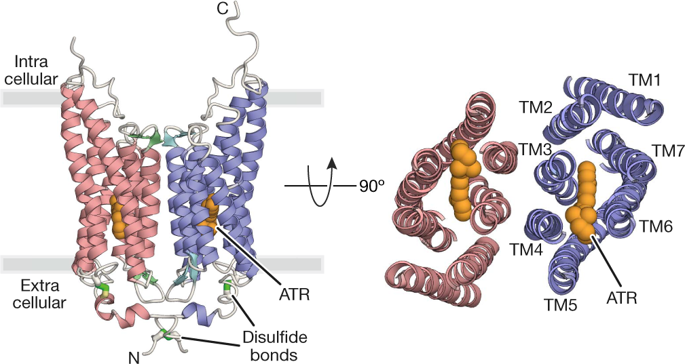Our official English website, www.x-mol.net, welcomes your
feedback! (Note: you will need to create a separate account there.)
Crystal structure of the natural anion-conducting channelrhodopsin GtACR1
Nature ( IF 50.5 ) Pub Date : 2018-08-29 , DOI: 10.1038/s41586-018-0511-6 Yoon Seok Kim 1 , Hideaki E Kato 2, 3 , Keitaro Yamashita 4 , Shota Ito 5 , Keiichi Inoue 3, 5, 6 , Charu Ramakrishnan 1 , Lief E Fenno 1 , Kathryn E Evans 1 , Joseph M Paggi 7, 8 , Ron O Dror 7, 8 , Hideki Kandori 5, 6 , Brian K Kobilka 2 , Karl Deisseroth 1
Nature ( IF 50.5 ) Pub Date : 2018-08-29 , DOI: 10.1038/s41586-018-0511-6 Yoon Seok Kim 1 , Hideaki E Kato 2, 3 , Keitaro Yamashita 4 , Shota Ito 5 , Keiichi Inoue 3, 5, 6 , Charu Ramakrishnan 1 , Lief E Fenno 1 , Kathryn E Evans 1 , Joseph M Paggi 7, 8 , Ron O Dror 7, 8 , Hideki Kandori 5, 6 , Brian K Kobilka 2 , Karl Deisseroth 1
Affiliation

|
The naturally occurring channelrhodopsin variant anion channelrhodopsin-1 (ACR1), discovered in the cryptophyte algae Guillardia theta, exhibits large light-gated anion conductance and high anion selectivity when expressed in heterologous settings, properties that support its use as an optogenetic tool to inhibit neuronal firing with light. However, molecular insight into ACR1 is lacking owing to the absence of structural information underlying light-gated anion conductance. Here we present the crystal structure of G. theta ACR1 at 2.9 Å resolution. The structure reveals unusual architectural features that span the extracellular domain, retinal-binding pocket, Schiff-base region, and anion-conduction pathway. Together with electrophysiological and spectroscopic analyses, these findings reveal the fundamental molecular basis of naturally occurring light-gated anion conductance, and provide a framework for designing the next generation of optogenetic tools.The crystal structure of anion channelrhodopsin-1 (ACR1) from the algae Guillardia theta provides insights into the basis of anion conductance.
中文翻译:

天然阴离子传导通道视紫红质 GtACR1 的晶体结构
天然存在的通道视紫红质变体阴离子通道视紫红质-1 (ACR1),在隐藻藻类 Guillardia theta 中发现,在异源环境中表达时表现出大的光门控阴离子电导和高阴离子选择性,支持其用作抑制神经元的光遗传学工具的特性用光射击。然而,由于缺乏光门控阴离子电导的结构信息,因此缺乏对 ACR1 的分子洞察力。在这里,我们以 2.9 Å 分辨率呈现 G. theta ACR1 的晶体结构。该结构揭示了跨越细胞外结构域、视网膜结合袋、席夫碱区和阴离子传导通路的不寻常的结构特征。连同电生理学和光谱分析,
更新日期:2018-08-29
中文翻译:

天然阴离子传导通道视紫红质 GtACR1 的晶体结构
天然存在的通道视紫红质变体阴离子通道视紫红质-1 (ACR1),在隐藻藻类 Guillardia theta 中发现,在异源环境中表达时表现出大的光门控阴离子电导和高阴离子选择性,支持其用作抑制神经元的光遗传学工具的特性用光射击。然而,由于缺乏光门控阴离子电导的结构信息,因此缺乏对 ACR1 的分子洞察力。在这里,我们以 2.9 Å 分辨率呈现 G. theta ACR1 的晶体结构。该结构揭示了跨越细胞外结构域、视网膜结合袋、席夫碱区和阴离子传导通路的不寻常的结构特征。连同电生理学和光谱分析,











































 京公网安备 11010802027423号
京公网安备 11010802027423号